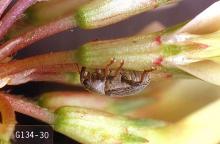Tychius picirostris
Pest description and crop damage A small gray weevil about 0.1 inch long. Larvae damage two to four seeds in each pod. Adults feed during bloom, and larvae feed within and destroy seeds. This pest can seriously infest white clover and needs routine control in western Oregon. They attack alsike, white, arrowleaf, and ladino clover but not red clover. Second-generation weevils neither harm seeds nor lay eggs. Although they will be in fields near harvest, they do require control before harvest. Apply insecticide after pollination when first blooms turn brown. Ensure bees have moved from field or the beekeeper has been notified. Use a sweep net to sample the weevil adults. Treat when an average of two or more weevils are found per straight-line sweep (90°).
Management-chemical control
Although bifenthrin (Battalion 2EC, Brigade 2EC, and Discipline) are labeled for treatment of clover seed weevil in clover grown for seed, this chemistry has been found no longer effective for control. Clover seed weevil is highly resistant to bifenthrin in the state for Oregon and continued use of this chemistry will likely increase clover seed weevil populations as predatory populations may be impacted.
- chlorantraniliprole (Vantacor) at 0.047 to 0.098 lb ai/A. Only use one application per cutting. maximum 4 applications per year. PHI 0 days. REI 4 hr.
- malathion (Malathion 5EC) at 0.93 lb ai/A. Minimum 14-day retreatment interval. Maximum 1.25 lb ai/A per cutting. PHI 0 days. Group 1B.


